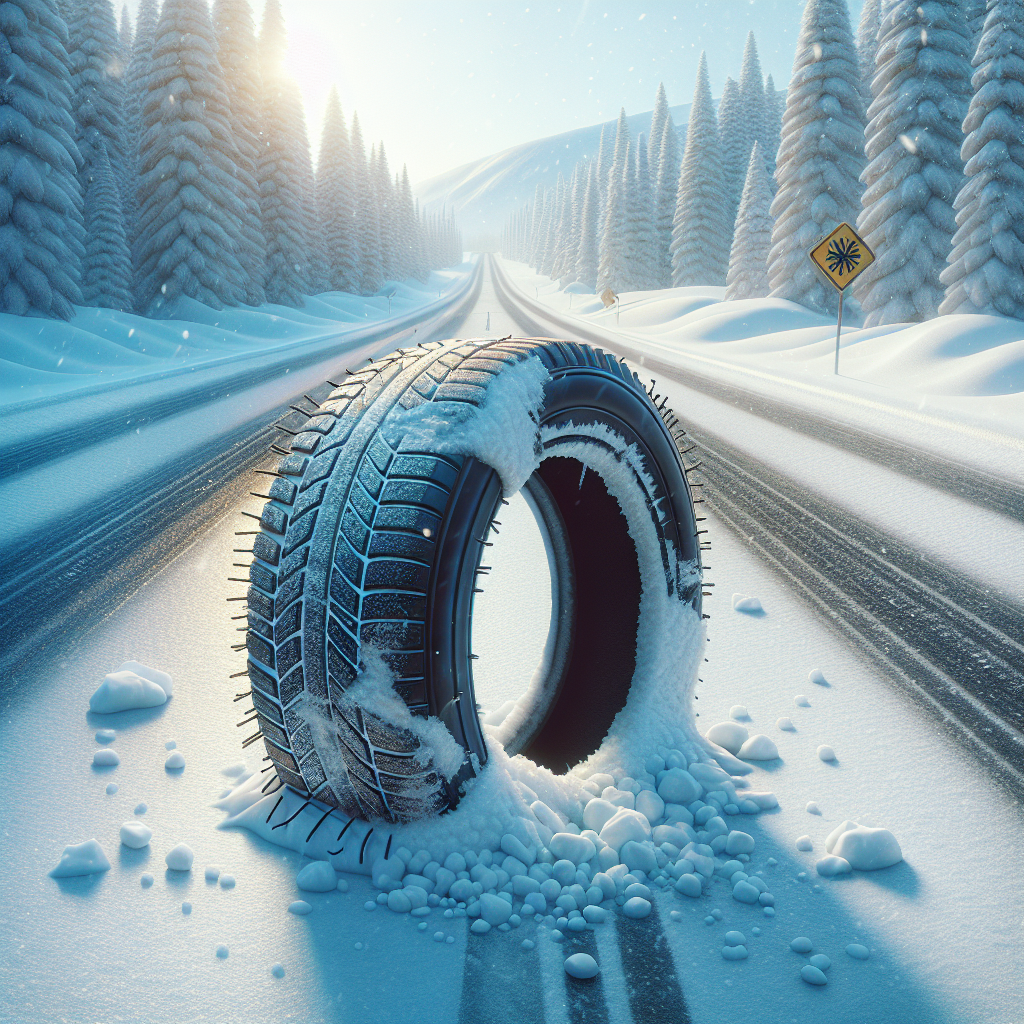Have you ever wondered about the potential drawbacks of using studded winter tires? While these tires are known for their excellent grip on icy roads, there are a few factors to consider before opting for them. From the increased road noise to the potential for damage to road surfaces, this article will explore some of the potential disadvantages of using studded winter tires.
Potential Drawback #1: Increased Road Noise
Noise Levels
One potential drawback of using studded winter tires is the increased road noise they produce. Studded tires have metal studs embedded in the tread, which can create a louder and more noticeable sound when driving on paved roads. The noise is primarily caused by the metal studs making contact with the road surface. This increased noise level may be bothersome for some drivers, especially during long commutes or on highways where the noise can become more pronounced.
Annoyance for Drivers
The increased road noise generated by studded winter tires can be quite annoying for drivers. The continuous sound of the studs hitting the pavement can be distracting and may affect the overall driving experience. It has been reported that the noise level can be as high as 10 decibels louder compared to non-studded winter tires. This constant noise can lead to driver fatigue and potentially impact concentration on the road, which can be dangerous.
Impact on Pedestrians
Not only do studded winter tires impact the drivers themselves, but they may also affect pedestrians. The loud noise created by the metal studs can startle pedestrians and other road users, potentially leading to an increased risk of accidents or mishaps. Pedestrians who are not familiar with the sound of studded tires approaching may also have difficulty accurately judging the distance and speed of an approaching vehicle, which could further contribute to potential safety concerns.
Potential Drawback #2: Reduced Fuel Efficiency
Increased Rolling Resistance
One significant drawback of studded winter tires is the reduced fuel efficiency they can cause. The metal studs on the tires create an extra source of rolling resistance, making it harder for the vehicle to move forward. As a result, more energy is required to overcome this resistance, leading to increased fuel consumption. This additional effort required by the engine to propel the vehicle forward ultimately leads to a decrease in fuel efficiency.
Engine Strain
The increased rolling resistance caused by studded winter tires can also put additional strain on the engine of the vehicle. The engine needs to exert more power to overcome the added resistance, leading to increased wear and tear over time. This strain on the engine can potentially reduce its lifespan and result in the need for more frequent maintenance or repairs.
Impact on Fuel Consumption
Studded winter tires can significantly impact fuel consumption. Studies suggest that using studded tires can reduce fuel efficiency by as much as 3% to 5%, depending on driving conditions and the vehicle’s characteristics. This decrease in fuel efficiency not only translates to increased costs for the driver but also has environmental implications due to the additional fuel consumption and subsequent emissions.

Potential Drawback #3: Deterioration of Road Surfaces
Physical Damage
One of the potential drawbacks of using studded winter tires is the potential damage they can cause to road surfaces. The metal studs can dig into the pavement, resulting in small holes or scratches. Over time, these minor damages can accumulate, leading to a deteriorated road surface. The road infrastructure already faces many challenges, and studded tires can exacerbate these issues, requiring increased maintenance and repair work to keep the roads in good condition.
Increased Maintenance Costs
The physical damage caused by studded winter tires can lead to increased maintenance costs for municipalities and road authorities. Repairing and maintaining roads damaged by studded tires, such as filling in holes or resurfacing sections, can be a costly undertaking. These additional expenses may ultimately be passed on to taxpayers or drivers through increased taxes or tolls. Moreover, the increased maintenance requirements can result in road closures or lane restrictions, inconveniencing drivers and potentially causing traffic congestion.
Potential Drawback #4: Limited Traction on Dry Roads
Reduced Braking Performance
While studded winter tires excel in providing traction on icy or snowy surfaces, they can have limited traction on dry roads. The metal studs that offer exceptional grip on slippery surfaces can actually reduce braking performance on dry pavement. The studs can prevent the tire’s rubber from adequately gripping the road, leading to longer stopping distances and potentially compromising safety in situations where sudden braking is required.
Decreased Handling and Cornering Abilities
Studded winter tires can also negatively impact the handling and cornering abilities of a vehicle on dry roads. The metal studs can reduce the tire’s ability to grip the road during turns, making it harder to maintain control and stability. This decrease in handling and cornering capabilities can pose risks, especially during evasive maneuvers or when navigating curvy roads.

Potential Drawback #5: Risk of Tire Damage
Potential for Tire Stud Loss
Another potential drawback of using studded winter tires is the risk of losing tire studs. As the vehicle travels, the constant contact between the metal studs and the road surface can cause them to become dislodged or sheared off. This can result in a loss of traction and compromised performance of the studded tires. Additionally, the presence of missing studs can lead to an uneven distribution of weight on the tire, potentially causing further damage to the tire or compromising its overall stability.
Damage to Road Surfaces
In addition to the physical damage to road surfaces mentioned earlier, studded tires themselves can cause damage to the roads. The metal studs can chip or scrape the pavement, leading to small fragments being dislodged. These fragments can contribute to the accumulation of debris on the road, posing a hazard to both drivers and pedestrians. Furthermore, the dislodged studs can become projectiles, potentially damaging vehicles or causing injuries to other road users.
Potential Drawback #6: Uneven Tire Wear
Premature Wear on Dry Roads
Studded winter tires are not designed for use on dry roads. As a result, using them under such conditions can lead to premature and uneven tire wear. The metal studs, which are essential for providing traction on icy surfaces, can cause excessive wear on the tire when driven on dry pavement. The studs can wear down faster than the tire’s tread, resulting in an uneven surface that can compromise the tire’s performance and longevity.
Wear Patterns Due to Sudden Temperature Changes
Another factor contributing to uneven tire wear with studded winter tires is the effect of sudden temperature changes. When driving from icy or cold conditions to warmer environments, the metal studs can create heat through friction as they make contact with the road. This heat buildup can cause the tire to wear unevenly, leading to potential irregularities in the tire’s tread pattern. These irregular wear patterns can affect the tire’s traction, stability, and overall performance, potentially compromising the safety of the vehicle.

Potential Drawback #7: Higher Initial Costs
Price of Studded Tires
One of the drawbacks associated with studded winter tires is their higher initial costs. Studded tires are generally more expensive than their non-studded counterparts. The metal studs embedded in the tire tread increase the manufacturing costs, which are then passed on to the consumer. This higher price tag can be a deterrent for some drivers, especially those on a tight budget or who may only require winter tires for a limited period.
Installation and Removal Expenses
In addition to the initial higher cost, using studded winter tires also involves additional expenses for installation and removal. Studded tires require specialized equipment and expertise to ensure proper installation, which may incur extra charges. Similarly, when the winter season ends, studded tires need to be removed and replaced with regular tires. This seasonal transition can involve additional costs, either for the labor required to switch the tires or for storing the studded tires until they are needed again.
Potential Drawback #8: Limited Availability and Seasonal Use
Restricted Availability in Some Regions
Studded winter tires may not be as readily available or practical in certain regions. Some areas may have specific regulations or restrictions on the use of studded tires due to various reasons like road preservation or environmental concerns. As a result, drivers in these regions may need to explore alternative solutions or rely on non-studded winter tires, which may have different performance characteristics and may not provide the same level of traction on icy surfaces.
Storage and On/Off Season Transitions
Another consideration when using studded winter tires is the logistics of storage and transitioning between winter and non-winter driving seasons. Studded tires should be stored properly when not in use to prevent damage and maintain their effectiveness. However, this requires adequate storage space and appropriate storage conditions. Additionally, the process of switching between studded and regular tires can be time-consuming and inconvenient, as it involves scheduling appointments or performing the tire change oneself. These logistical challenges can add complexity to the overall process of using studded winter tires.

Potential Drawback #9: Environmental Concerns
Increased Air and Noise Pollution
Studded winter tires have been associated with increased air and noise pollution. The metal studs used in these tires can release small particles into the air as they wear down, contributing to particulate matter pollution. These particles can be harmful to both human health and the environment, as they can be inhaled, potentially leading to respiratory issues. Moreover, the increased road noise generated by studded tires can contribute to noise pollution, impacting not only the drivers but also surrounding communities.
Microplastic Pollution
Studded tires can also contribute to microplastic pollution. The metal studs on the tires wear down over time, releasing microplastic particles into the environment. These microplastics can find their way into water bodies and other ecosystems, potentially causing harm to aquatic life and disrupting fragile ecosystems. Given the growing concern about microplastic pollution and its long-lasting environmental impact, the use of studded winter tires raises valid concerns regarding their contribution to this form of pollution.
Potential Drawback #10: Legal Restrictions
Prohibited in Some Areas
The use of studded winter tires may be prohibited or restricted in certain areas due to various reasons. Some regions implement bans or restrictions on studded tires to preserve road surfaces, as the metal studs can cause damage and result in increased maintenance expenses. Other areas may have restrictions to mitigate environmental concerns, such as limiting air and microplastic pollution. Compliance with these regulations is essential, as non-compliance can result in fines or penalties.
Specific Time Limitations
In addition to regional restrictions, there may be specific time limitations on the use of studded winter tires. Some areas only allow the use of studded tires during a particular period or season when icy or snowy conditions prevail. Outside of this designated time frame, drivers are required to switch to non-studded tires. These time limitations can require careful planning and preparedness to ensure compliance and the timely transition between different types of tires.
Overall, while studded winter tires offer enhanced traction on icy and snowy surfaces, it is crucial to consider the potential drawbacks associated with their use. These drawbacks include increased road noise, reduced fuel efficiency, deterioration of road surfaces, limited traction on dry roads, risk of tire damage, uneven tire wear, higher initial costs, limited availability and seasonal use, environmental concerns, and legal restrictions. By weighing these factors against the benefits and considering individual driving needs and local regulations, one can make an informed decision regarding the use of studded winter tires.


